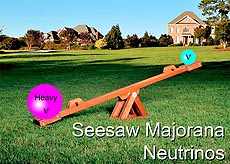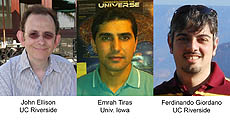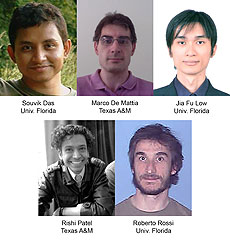Heavy neutrinos
 |
| Heavy neutrinos are proposed cousins of the familiar light neutrinos. The masses of the heavy and light neutrinos are connected: the heavier the heavy ones are, the lighter the light ones are. This connection is called the seesaw mechanism. |
With the discovery of the Higgs field, scientists think they have a pretty good handle on the origins of the mass of fundamental particles. Particles that interact with the field have mass, and those that don't, don't. However, the neutrino poses an additional mystery. Neutrinos have a very tiny mass, but not zero. Just why this should be is not known.
One very popular idea is that there is another kind of neutrino, a heavier kind of neutrino. In the theory, the masses of the ordinary neutrinos and heavy neutrinos are tied together. If one gets big, the other gets small. For this reason, the theory is colloquially called the seesaw mechanism. Heavy neutrinos have not been observed.
So naturally, CMS scientists went digging through their data to see if there was any evidence that heavy neutrinos were real. These searches hinge on the fact that neutrinos, both heavy and light, are a type of a particle called a Majorana particle in this theory. The defining characteristic of a Majorana particle is that it is its own antiparticle. An earlier Fermilab Today article describes this in more detail.
This analysis looked for a peculiar event signature, one in which two muons of the same charge are formed. Today's analysis is a follow-on of an earlier one also described in Fermilab Today. In the earlier article, I explained how Majorana neutrinos and two muons of the same charge are related. (Plus that article has a very cool graphic. Check it out!)
No evidence for heavy Majorana neutrinos was found, and CMS physicists used the measurement to set very strict limits on the range of possible masses for heavy Majorana neutrinos that are still allowed. As CMS resumes operations at 13 trillion electronvolts, physicists will study the new data, looking for even higher masses. You should expect another article on this subject in a couple of years, hopefully with a discovery!
—Don Lincoln
 |
| These physicists contributed to this analysis. (Ferdinando Giordano is now a postdoc at INFN/Catania.) |
 |
| These U.S. scientists are making crucial contributions to simulations to develop and design a future tracking trigger system for the high-luminosity LHC. |
|